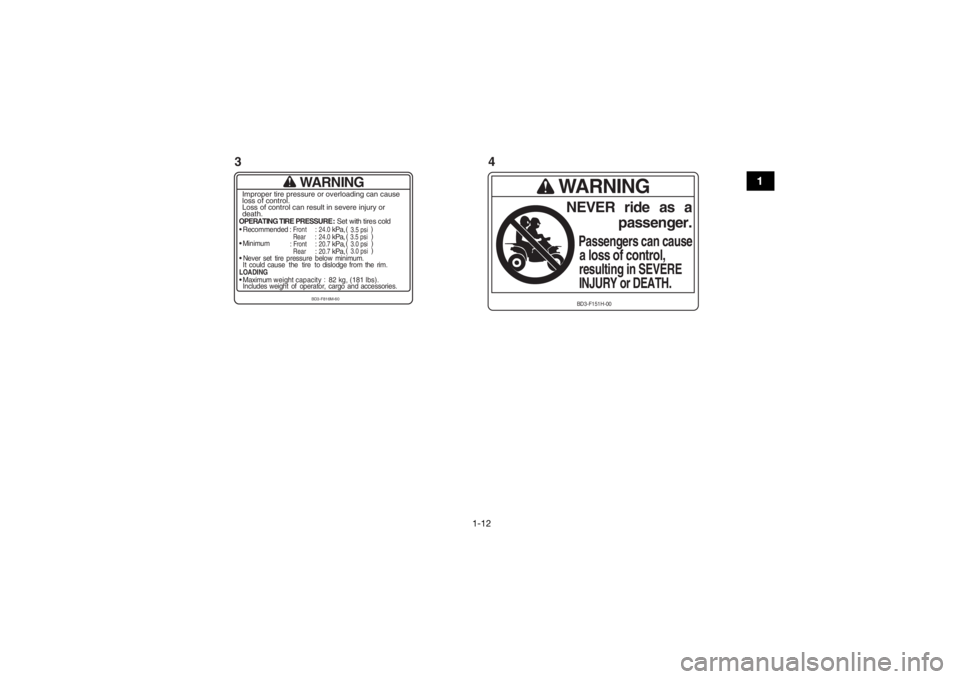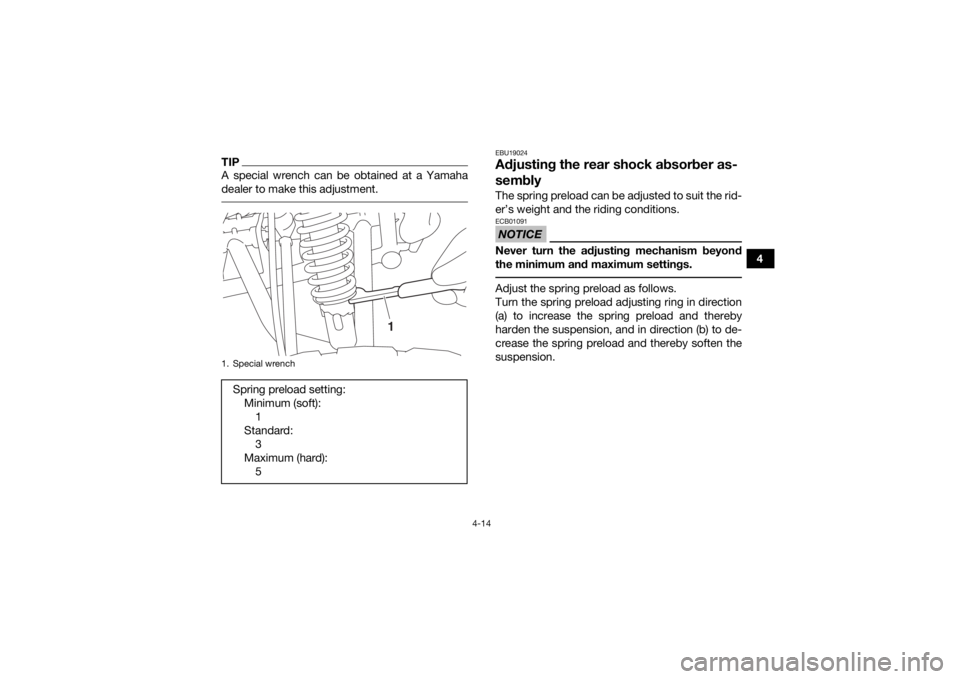2017 YAMAHA YFM90 weight
[x] Cancel search: weightPage 17 of 130

1-6
1
******
*** kW *** kg1
23
YAMAHA MOTOR CO., LTD.
2500 SHINGAI, IWATA, JAPAN
****1
1
2
3 Model Name
Max. Power
Mass In Running Order
1 Year of construction
This pictogram shows trailer Hitch Tow
weight limit. (Combined weight of the trailer
and all cargo in the trailer.)
Overloading can cause loss of control.
Loss of control can result in severe injury or
death.
This pictogram shows trailer Hitch Tongue
weight limit. (Weight on the trailer tongue.)
Overloading can cause loss of control.
Loss of control can result in severe injury or
death.
UBD361E0.book Page 6 Monday, January 25, 2016 10:53 AM
Page 23 of 130

1-12
1
WARNING
OPERATING TIRE PRESSURE : Set with tires cold
Recommended
: Front
: 24.0
kPa,
Rear
: 24.0
kPa,
Minimum
: Front
: 20.7
kPa,
Rear
: 20.7
kPa,
Never set tire pressure below minimum.
It could cause the tire to dislodge from the rim.LOADINGMaximum weight capacity :
82 kg, (181 lbs).
Includes weight of operator, cargo and accessories.Improper tire pressure or overloading can cause
loss of control.
Loss of control can result in severe injury or
death.
3.5 psi
3.5 psi 3.0 psi
3.0 psi(
( )
() () )
BD3-F816M-60
WARNINGNEVER ride as a
passenger.
Passengers can causea loss of control,resulting in SEVEREINJURY or DEATH.BD3-F151H-00
34
UBD361E0.book Page 12 Monday, January 25, 2016 10:53 AM
Page 25 of 130

2-2
2
Never operate at speeds too fast for your skills
or the riding conditions. Always go at a speed
that is proper for the terrain, visibility, operating
conditions, and your experience.
Never attempt wheelies, jumps, or other stunts.
Always inspect your ATV each time you use it to
make sure it is in safe operating condition. Al-
ways follow the inspection and maintenance
procedures and schedules described in this
manual.
Always keep both hands on the handlebars and
both feet on the footrests of the ATV during op-
eration.
Always go slowly and be extra careful when op-
erating on unfamiliar terrain. Always be alert to
changing terrain conditions when operating the
ATV.
Never operate on excessively rough, slippery or
loose terrain until you have learned and prac-
ticed the skills necessary to control the ATV on
such terrain. Always be especially cautious on
these kinds of terrain.
Always follow proper procedures for turning as
described in this manual. Practice turning at low
speeds before attempting to turn at faster
speeds and never turn at excessive speeds.
Never operate the ATV on hills too steep for the
ATV or for your abilities. Practice on smaller hills
before attempting larger hills.
Always follow proper procedures for climbing
hills as described in this manual. Check the ter-
rain carefully before you start up any hill. Never
climb hills with excessively slippery or loose
surfaces. Shift your weight forward. Never open
the throttle suddenly or make sudden gear
changes. Never go over the top of a hill at high
speed.
Always follow proper procedures for going
down hills and for braking on hills as described
in this manual. Check the terrain carefully before
you start down any hill. Shift your weight back-
ward. Never go down a hill at high speed. Avoid
going down a hill at an angle that would cause
the vehicle to lean sharply to one side. Go
straight down the hill where possible.
Always follow proper procedures for crossing
the side of a hill as described in this manual.
Avoid hills with excessively slippery or loose
surfaces. Shift your weight to the uphill side of
the ATV. Never attempt to turn the ATV around
on any hill until you have mastered the turning
UBD361E0.book Page 2 Monday, January 25, 2016 10:53 AM
Page 28 of 130

2-5
2ungrounded or broken wiring. Visually check
for broken wiring and leaking fuel. Leaking
fuel can be confirmed by the odor of gasoline.
4. Once immediate safety hazards are con- firmed not to exist, you may remove your hel-
met to more closely inspect your vehicle.
Check for external signs of wear, broken
parts, fluid leaks, cracks in the frame, sus-
pension damage, wheel damage, and so on.
Fuel, oil, and coolant usually give off a notice-
able odor.
5. If your vehicle will not restart or if it is unsafe to ride, then turn off all vehicle systems (en-
gine stop switch, main switch, and fuel cock),
and then signal or go for help.
Aftermarket Parts, Accessories, and Modifica-
tions
While you may find aftermarket products similar in
design and quality to genuine Yamaha accesso-
ries, recognize that some aftermarket accessories
or modifications are not suitable because of po-
tential safety hazards to you or others. Installing
aftermarket products or having other modifica-
tions performed to your vehicle that change any of
the vehicle’s design or operation characteristics
can put you and others at greater risk of serious injury or death. You are responsible for injuries re-
lated to changes in the vehicle. Keep the following
guidelines in mind, as well as those provided un-
der “Loading” when mounting accessories.
Never install accessories that would impair the
performance of your ATV. Carefully inspect the
accessory before using it to make sure that it
does not in any way reduce ground clearance,
limit suspension travel, steering travel or control
operation.
Accessories fitted to the ATV can create insta-
bility due to improper weight distribution.
Bulky or large accessories may seriously affect
the stability of the ATV.
Certain accessories can displace the operator
from his or her normal riding position. This im-
proper position limits the freedom of movement
of the operator and may limit control ability,
therefore, such accessories are not recom-
mended.
Use caution when adding electrical accesso-
ries. If electrical accessories exceed the capac-
ity of the ATV’s electrical system, an electric
failure could result, which could cause a dan-
gerous loss of lights or engine power.
UBD361E0.book Page 5 Monday, January 25, 2016 10:53 AM
Page 44 of 130

4-13
4
EBU18995Adjusting the front shock absorber as-
sembliesThe spring preload can be adjusted to suit the rid-
er’s weight and the riding conditions.
WARNING
EWB00401Always adjust the shock absorber assemblies
on the left and right side to the same setting.
Uneven adjustment can cause poor handling
and loss of stability, which could lead to an ac-
cident.
NOTICEECB01091Never turn the adjusting mechanism beyond
the minimum and maximum settings. Adjust the spring preload as follows.
Turn the spring preload adjusting ring in direction
(a) to increase the spring preload and thereby
harden the suspension, and in direction (b) to de-
crease the spring preload and thereby soften the
suspension.
Align the appropriate notch in the adjusting ring
with the position indicator on the shock absorber.
1. Projection
2. Seat holder
12
1. Spring preload adjusting ring
2. Position indicator
123 45
2
1(a)
(b)
UBD361E0.book Page 13 Monday, January 25, 2016 10:53 AM
Page 45 of 130

4-14
4
TIPA special wrench can be obtained at a Yamaha
dealer to make this adjustment.
EBU19024Adjusting the rear shock absorber as-
semblyThe spring preload can be adjusted to suit the rid-
er’s weight and the riding conditions.NOTICEECB01091Never turn the adjusting mechanism beyond
the minimum and maximum settings. Adjust the spring preload as follows.
Turn the spring preload adjusting ring in direction
(a) to increase the spring preload and thereby
harden the suspension, and in direction (b) to de-
crease the spring preload and thereby soften the
suspension.
1. Special wrenchSpring preload setting:Minimum (soft):1
Standard: 3
Maximum (hard): 5
1
UBD361E0.book Page 14 Monday, January 25, 2016 10:53 AM
Page 59 of 130

6-7
6
aftermarket products or having other modifica-
tions performed to your ATV that change any of
the vehicle’s design or operation characteristics
can put you and others at greater risk of serious
injury or death. You are responsible for injuries re-
lated to changes in the vehicle.
Keep the following in mind when considering an
accessory or operating an ATV which has acces-
sories.
Accessories should be rigidly and securely
mounted. An accessory which can shift position
or come off while you are riding could affect
your ability to control the ATV.
Do not mount an accessory where it could inter-
fere with your ability to control the ATV. Exam-
ples include (but are not limited to) a heavy or
bulky object attached to the handlebars which
could make steering difficult, an accessory that
limits your ability to move around on the seat, or
one that limits your view.
Use extra caution when riding an ATV with ac-
cessories. The ATV may handle differently than
it does without accessories.
EBU33880Loading
WARNING
EWB00821Never exceed the stated load capacity for this
ATV. Overloading this ATV or carrying or tow-
ing cargo improperly could cause changes in
ATV handling which could lead to an accident.
Cargo should be properly distributed and se-
curely attached. Reduce speed when carrying
cargo or pulling a trailer. Allow greater dis-
tance for braking. As originally equipped, this ATV is not designed to
carry cargo or tow a trailer. If you choose to add
accessories so that you can carry cargo or tow a
trailer, you must use common sense and good
judgment as the stability and handling of an ATV
can be changed. When adding accessories, keep
the following points in mind:
Never exceed the weight limits shown. An over-
loaded ATV can be unstable.
MAXIMUM LOADING LIMIT ATV loading limit (total weight of rider, car-
go, accessories, and tongue weight):82.0 kg (181 lb)
UBD361E0.book Page 7 Monday, January 25, 2016 10:53 AM
Page 60 of 130

6-8
6
If you are carrying cargo and towing a trailer, in-
clude the tongue weight in the maximum ATV
load limit.
Load cargo on the carriers as close to the center
of the ATV as possible. Put cargo at the rear of
the front carrier, at the front of the rear carrier,
and center it.
Tie down cargo securely to the carriers. Make
sure cargo in the trailer cannot move around. A
shifting load can cause an accident.
Make sure the load does not interfere with con-
trols or your ability to see where you are going.
Ride more slowly than you would without a
load. The more weight you carry, the slower you
should go.
Allow more braking distance. A heavier ATV
takes longer to stop.
Avoid making sharp turns unless at very slow
speeds.
Avoid hills and rough terrain. Choose terrain
carefully. Added weight affects the stability and
handling of the ATV.
UBD361E0.book Page 8 Monday, January 25, 2016 10:53 AM